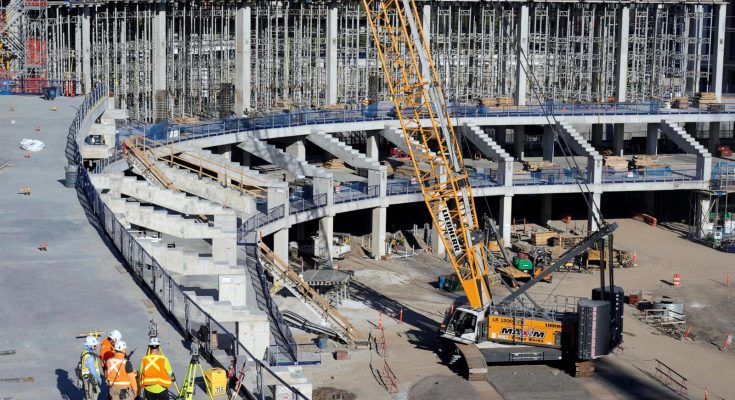A deeply disturbing discovery at the construction site of the Tennessee Titans’ new stadium has sent shockwaves through the NFL community and beyond. A noose—an object long associated with racial violence and hatred—was found on-site, triggering an immediate investigation and fierce condemnation from team officials, city leaders, the NFL, and civil rights organizations. The symbolism of such an object at a prominent and highly visible public project has reignited a painful national conversation around racism, workplace safety, and accountability in major developments involving public-private partnerships.
The incident came to light earlier this week when a construction worker reportedly spotted what appeared to be a noose hanging in an area under development. According to multiple sources close to the project, the noose was tied to a piece of scaffolding in an area that is typically accessed by a small crew. Once identified, the object was immediately removed and reported to site supervisors, who in turn contacted law enforcement and the Tennessee Titans organization.
The new Titans stadium is a major infrastructure project in Nashville, anticipated to cost over \$2 billion and serving as the future home of the franchise by the 2027 NFL season. The stadium, being built near the current Nissan Stadium along the East Bank of the Cumberland River, has drawn attention for its scope, modern design, and financial partnership between the team and the city. That attention has now been turned toward a much darker issue: how such a hateful symbol could appear on a site that employs hundreds of workers and is meant to stand as a beacon of progress.
The Titans organization released a swift and strongly worded statement condemning the act, calling the presence of the noose “repugnant and completely unacceptable.” They vowed to cooperate fully with all investigative bodies and to ensure that every worker on the site feels safe and respected. “We are disgusted by this symbol of hatred and intolerance. It has absolutely no place in our community or our workplace,” the statement read. “We are working with our contractors and law enforcement to determine how this happened and who is responsible. We will not rest until those responsible are held accountable.”
The FBI has been notified and is expected to take part in the investigation, alongside local authorities and the Occupational Safety and Health Administration (OSHA), which has jurisdiction over safety on construction sites. Given the noose’s long-standing association with racial terrorism, particularly the lynching of Black Americans throughout U.S. history, the incident is being treated as a potential hate crime. Federal law prohibits the use of threatening symbols in the workplace, especially those that can create a hostile or unsafe environment.
While the identity of the perpetrator or perpetrators remains unknown, law enforcement is reportedly reviewing surveillance footage from the site and interviewing workers, supervisors, and security personnel. Multiple contractors and subcontractors are involved in the stadium project, complicating the task of tracing who had access to the specific area where the noose was found. A senior official involved in the construction confirmed that attendance logs and entry records are being reviewed for any inconsistencies or suspicious activity.
The incident has not only triggered an investigation, but it has also reignited the debate around racism and systemic issues in the construction industry—a sector historically fraught with discriminatory practices, underrepresentation of minority workers, and lax enforcement of harassment policies. In a region with deep racial histories, the placement of such a violent symbol carries an added weight and has been taken extremely seriously by civil rights groups.
The NAACP Tennessee chapter issued a statement expressing deep concern, saying, “This act is more than just a symbol—it is an explicit threat and a painful reminder of this country’s ugly past. We demand transparency in the investigation and immediate action to ensure that every worker on this site is safe, respected, and protected.” Other community leaders echoed similar sentiments, noting that incidents like this often go unreported or under-investigated unless public pressure is applied.
Local government leaders, including Nashville Mayor Freddie O’Connell, addressed the media shortly after the news broke. “This is a vile act and a direct affront to everything our city stands for,” he said. “We will work with the Titans, law enforcement, and labor leaders to get to the bottom of this. Hate has no place here.” The mayor also hinted at potential reviews of diversity, equity, and inclusion policies among contractors involved in the stadium’s construction.
The Titans’ stadium project is one of the most ambitious sports infrastructure developments in recent memory. Scheduled to seat around 60,000 fans with a translucent roof and multi-use flexibility, it represents the city’s aspirations to become a major hub for sports, entertainment, and economic growth. But the presence of a noose now threatens to overshadow the project’s vision with fear and controversy.
For workers on-site, the mood has reportedly shifted from excitement to unease. Several construction workers, speaking anonymously for fear of reprisal, said that while there had been no prior open signs of racial tension, the discovery has created a new atmosphere of distrust. “I’ve been on a lot of jobs, but this one hit different,” said one worker. “You start looking over your shoulder. You wonder if someone you’ve been working next to is the one who did it.”
Union leaders representing laborers on the project have called for immediate bias training, a full review of security procedures, and for diversity and inclusion officers to be brought in to help re-establish trust. One labor representative noted that symbols like nooses aren’t just disturbing—they are used historically to intimidate and silence people of color in workplaces. “When you see something like this, it’s not just a prank or bad joke. It’s meant to send a message, and that message is fear,” he said.
The NFL, too, has weighed in. In a joint statement with the Titans, the league expressed its condemnation of the act and affirmed its commitment to fighting racism and discrimination. The NFL, which has faced its own criticisms in recent years around issues of race and social justice, said it would support all necessary actions taken to hold the perpetrators accountable.
This incident also occurs at a time when the NFL is increasingly emphasizing social justice as a core organizational value. From end zone messages reading “End Racism” to the Inspire Change campaign, the league has tried to position itself as a platform for equity and inclusion. However, high-profile events like this test the sincerity and implementation of those values.
Public reaction has been swift and impassioned. Social media was flooded with reactions ranging from sorrow to outrage. Activists and fans alike expressed disappointment and anger that such an incident could occur in 2025 on a site so closely tied to community and national pride. Titans players and coaches, many of whom have spoken out on social justice issues in the past, are expected to address the situation in the coming days as training camp activities begin.
The team’s star running back took to social media shortly after the story broke, writing, “This makes me sick. We all deserve to work and live without fear. I stand with everyone on that site and in this city who’s hurting right now.” Other players echoed similar sentiments, calling for justice and demanding transparency throughout the investigation.
This moment poses a major challenge not just for the Titans or Nashville, but for the broader sports world as it continues to reckon with the intersection of race, labor, and corporate responsibility. The discovery of a noose in such a public and high-profile setting will inevitably raise questions about workplace culture, vetting procedures for subcontractors, and the measures in place to prevent hate-fueled acts in environments meant to bring people together.
The Titans’ response will be closely scrutinized. How they communicate with the public, how they treat the investigation’s findings, and how they engage with affected communities and workers will shape their reputation long after the stadium is completed. In moments of crisis, words matter—but actions matter more.
Ultimately, this incident is a tragic reminder of the work still left to be done—not just in removing symbols of hate, but in transforming the systems that allow them to persist in the shadows. Whether the Titans and the city of Nashville rise to meet that challenge could define not just the legacy of a stadium, but the moral compass of a community in transition.


